African Birds:- What do Martian eagles, Gymnogenes, Ibises, rollers, Hornbills, egrets, Hammerkops, weavers, flycatchers, Bee-eaters, starlings, parrots, vultures, cranes, curlews, plovers, flycatchers, mousebirds, ostriches, and sunbirds have in common?
They are found in Africa. From the deserts and dry flat savannahs to the mountainous or rain forests to the lakes and oceans of Africa, a variety of African birds for pets or study.
Their body makeup, feather types and colors, food preferences, hunting styles, and vocalisms is quite diverse.
Read About
- Top 10 Amazon Parrot Species
- Top 5 Pet Cockatoo Birds
- Top 15 Tropical Birds Species
- Top 10 Song Birds Species
- Top 5 Ornamental Birds Species
- Top 10 Macaws Birds Species
List of African Birds
African Birds | From (A to C)
African Grey Parrot

African Grey Parrot is one of the best-looking African birds species. Like other equatorial birds, African Grey Parrots are used to a warm climate and abundant forests where they can feed upon delicious fruits and vegetables.
In captivity, foods such as mangoes, papaya, cantaloupes, fresh peppers, peanuts, and raspberries; kiwi, pineapple, and star fruit are suitable for your African Grey Parrot.
As a companion, this intelligent bird can learn as many as 1,000 words and combine them to describe his needs like a five-year-old child.
African Raven
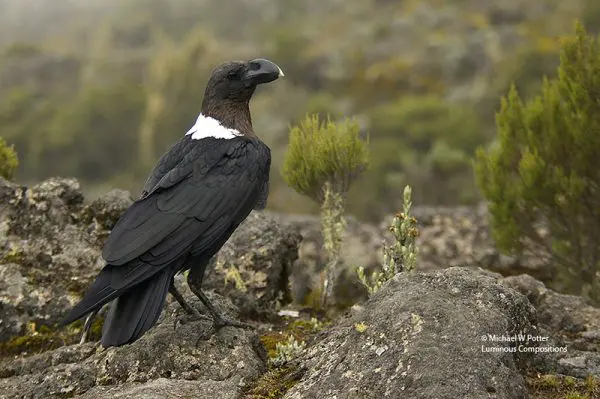
Next queued in the list of best African birds species is the African white-necked raven, the largest of crow-type birds, has historical symbolic associations: evil linked to their deep-throated utterances; uncleanness (biblical scripture;) wisdom, and power (medieval;) navigators (Norse mythology;) and creator (Native Americans.)
A scavenger of plants, carrion, and small animals, this raven is known to stash food or items of interest; to change their nests with different substances adjusting for environmental changes; to mate for life, and to have a limited vocabulary.
Cape Parrot

A very rare Old World bird in the wild and captivity is the Cape Parrot. The only true Cape, Robustus (P.r.r), comes from South Africa does not exist in the US.
Since two family members, Suahelicus (P.r.s) or Grey-Headed Parrot from central southern Africa and the Fuscicollis (P.r.f) or Brown-necked Parrot from southwestern Africa have been reclassified. On the decline, their import is banned. Capes are gentle, medium-sized, very intelligent, and speak well.
Catalina Macaws

Catalina Macaws appeared as the result of crossbreeding of Scarlet Macaws with Blue and Gold Macaws.
These parrots are very large and very noisy. It is very important for potential owners to learn as much as possible about these birds because improper socialization can result in destructive behavior.
Catalina Macaws are brightly colored, and this makes them popular among pet lovers. These birds can be found in Mexico and South America.
Congo African Grey Parrot

Easily adaptable when young, they can be left alone for a while. Congo African Grey Parrots make good pets to quiet homes without children. They bond well to one person or sex.
They are very shy, playful and intelligent, but can easily become bored. Thus, they do well with lots of chewable objects and nontoxic tree branches. They are considered the best talking of parrots and live up to 50 years.
African Birds | From (D to H)
Francolin

This African bird is found primarily in dense bush and woodland across Kenya, Sudan, Ethiopia, western Somalia, Uganda, Tanzania, Mozambique, Angola, and NE South Africa.
The Black Francolin (thought to originate from the Indian subspecies) is more common in North America. Francolins congregate in pairs or small groups on bare ground preferring to flee from danger on the ground. In captivity, some do well while others do not, partly because so little is known about them.
Goffin Cockatoos

Goffin Cockatoos can be found on the Banda Sea Islands of Yamdena and Lariat (Tanimbar) in Indonesia, and they are rather large, having white plumage.
They do not have a smaller crest, than that of other species of the Cockatoo group, but they are as smart and talkative, as most of their Cockatoo cousins.
They are 12-13 inches long from tail to beak, and they possess a very friendly and docile temperament. Goffins are expensive, prices ranging between $800 and $1100.
Hahn’s Macaws

Hahn’s Macaws are smaller than other Macaws, and they reach 13 inches in length. They can be found in eastern South America, particularly in the tropical woods north of the Amazon of Brazil. Hahn’s Macaws have bright green plumage with red feathers under the wings.
The face is bare, featuring tiny black feathers, and there is a distinctive blue crown on top of the head and on the forehead. Hahn’s Macaws are easy-going and sociable.
Harlequin Macaw

The Harlequin Macaw was developed by crossbreeding a Green Wing Macaw with a Gold and Blue Macaw.
They are often confused with Catalina Macaws, because they have similar color patterns, but Harlequins appear to be slightly bigger than Catalinas.
They have red-orange chests, green or bluish wings, and big heads with a green top. Harlequin Macaws are very good-tempered, and they possess the laid-back nature of Greens and the playfulness of Blues and Golds.
Hornbill
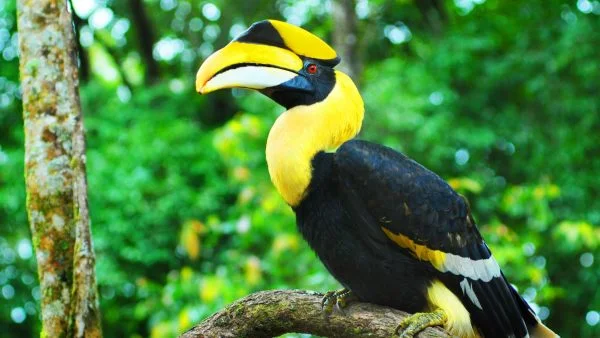
Natively, the 54 hornbill species inhabit the tropical zone of Africa and Asia. They have a great curved disproportionate bill and hollow casque (except the helmeted species) above the bill.
Except for spotted white wing coverts and a colored beak, these birds are mostly black-white, grey, or brown feathered.
They eat worms, insects, and fruit (figs preferred) and nest in tree hollows uniquely decorated at the opening with wood pieces, dried grass, dried mud, and its dung.
African Birds | From (I to O)
Jardine Parraot

An African Conure, Jardine parrot learns a reasonable vocabulary with the owner’s persistence. These birds are generally quiet, but their vocalizations are low-key whistles, chirps, squeaks, and assorted musical chattering.
A Jardine has black and green wings, a green head, and an underbelly with an orange/red forehead, socks, and a leading edge of the shoulder/wing (sub-species may vary.)
It is a curious, playful parrot with good talking potential and steady temperament capable of charming with goofy mannerisms, sideways swaggers, and lying on their backs.
Lilac Breasted Rollers
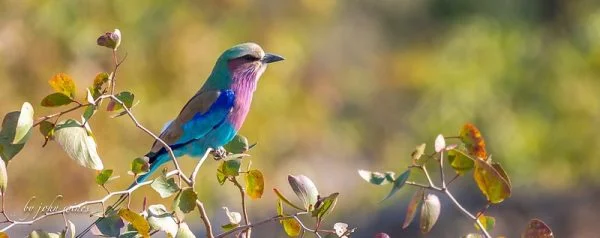
Abundant in Kenya but common throughout most of the African acacia range, these birds are swift, territorial, and vocal. They perch on treetops and swoop down to scoop their prey, mostly lizards and small vertebrates.
They nest in trees or termite rounds whereby they lay their eggs. Both sexes incubate the eggs. Their body is pale greenish-blue; however, as their name suggests, the base of their throat and breast and their rump are pale violets.
Meyers Parrot

The Meyer’s parrots inhabit the African moist woodlands and savannah edges. They eat seeds, nuts, berries, and cultivated grain.
Because of the numbers of captive Meyer’s parrots and the interbreeding with lack of full understanding of the 6 subspecies, captive subspecies of Meyers are difficult to identify.
Also visual sexing can be difficult (DNA testing recommended,) but generally the cock has a larger beak, larger head and the head tends to be flatter on the top.
Moluccan Cockatoos
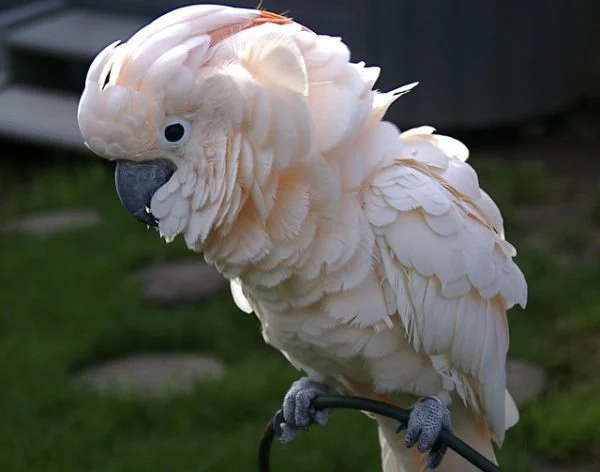
Moluccan Cockatoos are native to Seram and the surrounding islands of the Indonesian archipelago. They are fairly large and pink in color.
Of all Cockatoos, these species seem to possess the freest and independent temperament.
This is in no way a bird for everyone, and these parrots are not easily bred in captivity. Males can be very aggressive, and they tend to take the whole thing out on females and often kill them.
Ostriches

Before ancient cultures used their feathers as a statement of nobility and fashion, the ostriches existed millions of years ago in southern Eurasia.
Today, they are native to South Africa. Their 100-year successful product exports to the fashion industry led to commercial ostrich farms elsewhere but switched from fashion to such products as leather, eggshell ornaments, containers, and meat similar to beef but lower in fat, calories, and sodium than beef, emu, chicken, or turkey.
African Birds | From (P to Z)
Pied Crows
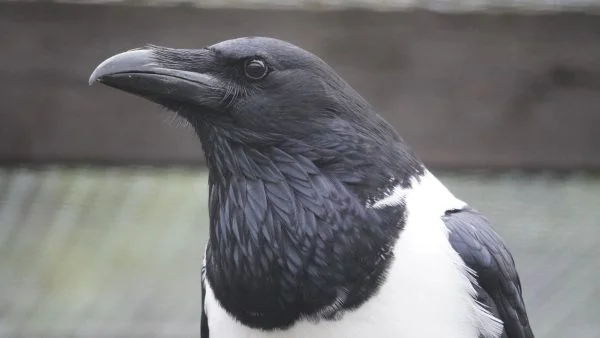
Similar to other crows, Pied Crows have black bodies, except the white that extends from shoulders to the breast.
Commonly seen nearby African human populations, they eat human orts. Not completely dependent on urban zones, they eat ground food: insects, invertebrates, reptiles, mammals, young birds, eggs, grain, and groundnuts.
A nest contains 3-6 eggs and is built in trees or pole crossings. Fledglings emerge 18-19 days leaving about 45 days later. Both sexes rear their young.
Rainbow Lorikeet

Rainbow Lorikeets are the world’s most colorful parrots. They can be found in north-east Australia in rainforests, heathlands, and open forests.
Rainbow Lorikeets are very sociable, and at night time they move in flocks, which may count hundreds of species.
They feed on berries, fruits, tree bark, seeds, small insects, and grubs. Rainbow Lorikeets reach sexual maturity at 2 years of age. Clutches count 2 eggs and take 25-26 days to hatch.
Red Bishop
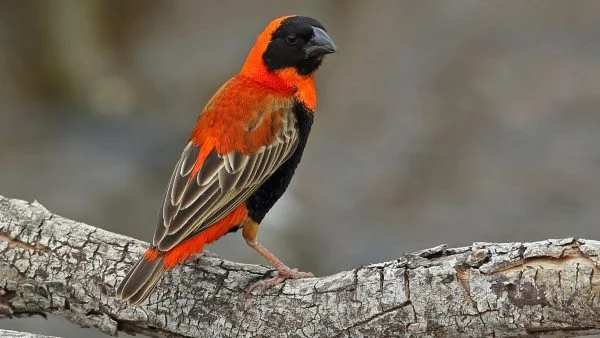
The red bishops are somewhat small birds that striking with their scarlet and black breeding plumage and are common throughout most of southern Africa except where permanent water sources are lacking.
The common flocking and roosting practices with other species combined with the non-breeding coloration may conceal this bird from proper identification.
They chiefly inhabit grassland areas for food and nesting, seasonally migrate away, but come back for breeding.
Scarlet Macaw

Scarlet Macaws are large in size, reaching 34-36 cm in length. Like all other Macaws, they are brightly colored and easy-going.
However, these Macaws can be possessive about their owners and wary of strangers. If mistreated, they can display aggression and fear of their masters, and they are vulnerable to dramatic changes in the environment.
Scarlet Macaws are red, with yellow upper wing and blue rump, horn upper and black lower mandible, and pinkish face.
Senegal Parrot

The popular Senegal parrot has green feathers and a gray head with the 3 subspecies differentiated by “vest” color (yellow, red, and orange.)
Feeding on seeds, fruits, and grain on the African savannahs and moist woodland areas, farmers consider them as pests.
As pets, they are easy to keep, not very noisy, whistlers and talkers that mimic a sundry of sounds. Although they bond to one person, they will switch affections and will bite if excited or belligerent.
African Grey Timneh

One of 3 African Grey subspecies is the African Grey Timneh. It differs from Congo namely in a smaller size, maroon tail, and bone-colored upper third mandible.
Possessing much the same traits as their Congo cousins, they can talk, cuddle, be playful, and perform; however, some say they are less high-strung.
They diet on seeds, nuts, fruits, berries, nectar, palm oil fruits, and occasionally millet while inhabiting lowland forests, treed savannahs away from humans.
Umbrella Cockatoos

Umbrella Cockatoos are large in size, measuring 18 inches. The bird’s face wears an enchanting smiling expression, accentuated by sparkling black eyes.
The big crest on top of the head adds a glorious element to the parrot’s appearance when held erect.
Umbrella Crested Cockatoos have a fine white plumage, which covers the whole body. These birds originated in Indonesia in overgrown areas. In captivity, they make wonderful pets, but they can be extremely noisy.